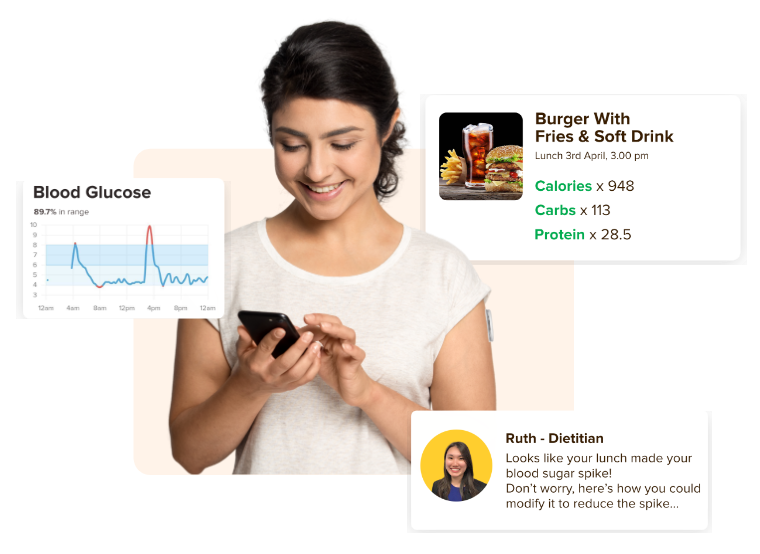Introduction to Freestyle Libre Sensor (FSL)
📉 What is the FreeStyle Libre Sensor (FSL)?
The FreeStyle Libre Sensor (FSL) is a Continuous Glucose Monitor. It is a small device that continuously monitors your blood sugar levels in more or less real-time. With the FSL, you can see your blood sugar levels with just a scan of your smartphone.
The FSL is worn on your arm and will work for 14 days. After 14 days, you can peel it off like a sticker.
How does the FSL work?
The sensor uses a thin, flexible filament inserted just under the skin to measure glucose levels every minute from the interstitial fluid.
The sensor filament is less than 0.4 mm in diameter and is inserted 5 mm under the surface of the skin.
How does the FSL benefit me?
By allowing you and your NOVI doctor/health coach to see your blood sugar trends, you will be able to gain insights into your metabolism and understand your health better.
Coupled with NOVI’s coaching program, your NOVI doctor/health coach will be able to help you learn how food, sleep, stress, and physical activity affects your blood sugar levels, and provide you with highly personalised advice for better health.
Is the FSL useful even if I don’t have issues with my blood sugar (e.g. diabetes)?
Definitely! Even in healthy individuals, our blood sugar levels fluctuate throughout the day. Reducing these fluctuations can help to improve energy levels and mood.
The FSL can also help you identify foods that your blood sugar is more sensitive to, so that you can learn how to better optimize your diet.
Lastly, in some cases our NOVI team will be able to pick up early signs of abnormal blood sugar regulation, allowing us to provide relevant advice and prevent disease.
🤳 How often to scan your sensor
You need to scan the sensor at least once every eight hours. The sensor only holds 8 hours of data, so it is important to scan before going to sleep and when you wake up in the morning.
FAQ
-
Yes. The sensor is water-resistant and you can use it while bathing, showering, swimming or exercising.
However, the sensor should not be submerged in water deeper than 1 metre or kept underwater for longer than 30 minutes at a time.
If you are swimming, the sensor will hold the data while swimming. After swimming, you should scan the sensor for information on your glucose levels.
-
If you encounter any errors or other issues with the sensor, reader or app, you can contact Abbott’s Customer Service:
Call 1800 272 2881 (toll-free)
Call +65 3158 2577 (if dialing from overseas)
Email ADC-CS.SG@abbott.com
Available from Mondays to Fridays from 8:30am-5:30pm (excluding public holidays)
-
Please contact Abbott’s Customer Service:
Call 1800 272 2881 (toll-free)
Call +65 3158 2577 (if dialing from overseas)
Email ADC-CS.SG@abbott.com
Available from Mondays to Fridays from 8:30am-5:30pm (excluding public holidays)
When contacting them, please have the serial number of your sensor ready. The serial number can be found in the Freestyle LibreLink App (Settings > About) as well as on the box of the sensor.
Please have your sensor by your side as you seek assistance.
-
CGMs do not actually measure your blood sugar (glucose) level; instead, it measures the amount of glucose in the fluid surrounding your body cells (known as interstitial fluid).
Glucose diffuses between the blood and the interstitial fluid. While they are strongly correlated, at times, blood glucose levels and interstitial glucose measurements may differ. Your glucose level in the capillary (a small blood vessel) will rise or fall ahead of the levels in the interstitial fluid.
There can be a lag time of 5-15 minutes of delay in interstitial fluid glucose in response to changes in blood glucose. This can happen particularly during times when your blood glucose is changing quickly, for example after eating, taking insulin, or exercising. This lag time does not impact the usefulness of the CGM since we are interested in the glucose trends and patterns as well as the direction and speed of these changes.
With the CGM, it is more important to focus on the patterns and time in range rather than on the absolute values.
The only time that it is important to cross-check the value seen on a CGM reading with a finger prick is when you have a low reading on your CGM, and are on insulin therapy or sulfonylureas, and you wish to confirm that reading and initiate rescue therapy.
Watch this video to learn more about the differences between interstitial and blood glucose.




